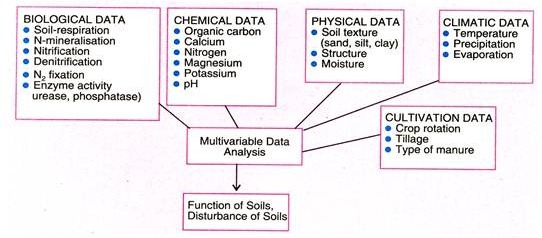In this article we will discuss about the definition of soil fertility.
Soil fertility is the sustainable capacity of a soil to produce good yields of high quality on the basis of chemical, physical and biological factors. The three factors are needed to assess soil quality or fertility. Much work has been done on physical, chemical, climatic and cultivation data. But biological soil components have never been used to assess soil quality.
The parameters for estimation of biological factors are soil respiration, nitrogen mineralisation, nitrification, denitrification, nitrogen fixation, soil enzyme activity (e.g. urease, acid phosphatase and alkaline phosphatase, etc.).
The level of microbial biomass of a soil denotes soil quality at a time on the basis of above parameters. Fig. 30.5 shows the integrated evaluation of biological, chemical, physical, cultivation and climatic data.
 Fig. 30.5 : Integrated evaluation of biological, chemical, physical, cultivation and climatic data for a soil which shows functioning of soil. These also act as indicators of disturbances arising in soil.
Fig. 30.5 : Integrated evaluation of biological, chemical, physical, cultivation and climatic data for a soil which shows functioning of soil. These also act as indicators of disturbances arising in soil.
Soil Function:
The basic natural function of soil system should be:
(i) Primary production by creation a rooting substrate,
(ii) To support above ground,
(iii) To decompose organic material resulting in release of simple organic compounds and minerals,
(iv) To exchange gases, solutes and organisms between the aqueous, solid and gas phases, and
(v) To support diversity of live forms and their adaptations, in response to heterogeneous physical, chemical and biological conditions.
Microbial Biomass as an Index of Soil Fertility:
In recent years, the role of microorganisms in decomposition of organic matter and mineralization of bio-elements, and more specifically the large pool of mineral nutrients in their cytoplasm and their turn over into the soil again available to plant roots, have been much studied in many countries including India.
Microbial biomass, irrespective of soil types, is a part of soil organic matter which includes the living microbial components i.e. bacteria, actinomycetes, fungi, algae, protozoa and other microfauna. Microbial biomass is influenced by affecting the microbial activity. Singh (1989) have advocated that the microbial biomass in nutrient poor system acts as a sink and a source of nutrients.
It accumulates during dry period and releases these rapidly during monsoon period so that plant growth can be started. This accumulation of nutrients is called immobilization. Thus in nutrient-poor ecosystem, nutrient retention and withdrawal mechanisms are effective.
Cultivation leads to considerable loss of soil organic matter and, therefore, microbial biomass also changes. The turn over time of microbial biomass is estimated at 1-3 years.
Since microbial biomass is the most active fraction of soil organic matter, therefore, any change in organic matter may be supposed that microbial biomass too has changed. Singh and Singh (1995) have found that microbial biomass is associated with water-stable macro and micro aggregates in forest, savana and cropland soils of a seasonally dry tropical region.
